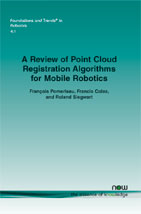A Review of Point Cloud Registration Algorithms for Mobile Robotics
By François Pomerleau, University of Toronto, Canada, f.pomerleau@gmail.com | Francis Colas, Université de Lorraine, Vandoeuvre-lès-Nancy, France, francis.colas@inria.fr | Roland Siegwart, ETH Zurich, Switzerland, rsiegwart@ethz.ch
Abstract
The topic of this review is geometric registration in robotics. Registration algorithms associate sets of data into a common coordinate system. They have been used extensively in object reconstruction, inspection, medical application, and localization of mobile robotics. We focus on mobile robotics applications in which point clouds are to be registered. While the underlying principle of those algorithms is simple, many variations have been proposed for many different applications. In this review, we give a historical perspective of the registration problem and show that the plethora of solutions can be organized and differentiated according to a few elements. Accordingly, we present a formalization of geometric registration and cast algorithms proposed in the literature into this framework. Finally, we review a few applications of this framework in mobile robotics that cover different kinds of platforms, environments, and tasks. These examples allow us to study the specific requirements of each use case and the necessary configuration choices leading to the registration implementation. Ultimately, the objective of this review is to provide guidelines for the choice of geometric registration configuration.
Particle Filters for Robot Navigation
This monograph addresses the problem of geometric registration and the classical Iterative Closest Point (ICP) algorithm. Though commonly used in several research fields, the focus here is on mobile robotics in which point clouds need to be registered. Even with this narrowed focus, the problem is still complex and multiple-faceted. A lot has been published on the topic, and, up until now, it has lacked a general comparison methodology. This is understandable given the diversity of applications, characteristics of the sensors, motion capabilities of the robotic platform and characteristics of the environments, but it hinders the selection process of an appropriate instance of the algorithm. This review tackles this challenge by three means: (1) a wide literature review with a historical perspective, (2) the elaboration of a theoretical descriptive framework of geometric registration grounded in the literature review, and (3) the analysis of practical use cases covering a wide diversity of mobile robotics applications. The end result provides the reader with a set of guidelines for the choice of geometric registration configuration.
